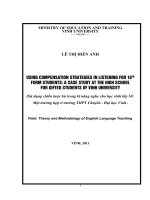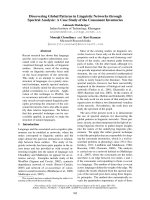Anonymity, motivations and participation in virtual learning communities a case study in the integrated virtual learning environments (IVLE)
Bạn đang xem bản rút gọn của tài liệu. Xem và tải ngay bản đầy đủ của tài liệu tại đây (1.07 MB, 118 trang )
ANONYMITY, MOTIVATIONS AND PARTICIPATION IN VIRTUAL LEARNING
COMMUNITIES:
A CASE STUDY IN THE INTEGRATED VIRTUAL LEARNING ENVIRONMENT
(IVLE)
SHEN CUIHUA
(B.A., ZHEJIANG UNIVERSITY)
A THESIS SUBMITTED
FOR THE DEGREE OF MASTER OF ARTS
INFORMATION AND COMMUNICATION MANAGEMENT PROGRAMME
NATIONAL UNIVERSITY OF SINGAPORE
2005
ii
Acknowledgements
I am greatly indebted to my supervisor, Dr Hichang Cho for his great patience and
guidance, without which the writing of this thesis would be an impossible mission. I
would also like to express my gratitude to all the faculty members of Communications and
New Media Programme (the former ICM) for their inspiring lectures and seminars.
I am thankful to Wang Yi for insightful comments on the draft of this thesis, and
other fellow graduate students of CNM Programme (the former ICM) who have made my
master’s years an enjoyable and memorable experience. My gratitude also extends to the
registered students of IF3204 “E-Learning” in Semester II, 2003-2004 Academic Year for
participating in my experiment and giving up their precious time to finish the
questionnaire.
Finally, I am grateful to my parents and my fiancé for their constant love and
support. Without you, what’s the point?
iii
Table of Contents
Contents
Page
Acknowledgements
ii
Table of Contents
iii
Summary
v
1. Introduction
1
2. Theoretical Background
2.1 Virtual communities and CMC
2.2 Learning Communities/Communities of Practice
2.3 Motivational Perspective in Virtual Learning Communities
2.3.1 Intrinsic and Extrinsic Motivations
2.3.2 Communication Dilemmas in Sharing Discretionary
Information
2.3.3 Motivations and Barriers to Participation in Virtual
Communities of Practice
2.4 Anonymity and Its Impact on Virtual Learning Communities
2.5 The Research Questions
6
6
10
14
15
3. Methodology
3.1 The Research Setting
3.2 Research Design and Data Collection
3.3 Measures
3.3.1 Participation
3.3.2 Motivations and Barriers
3.3.3 Attitude towards IVLE forum
3.3.4 Other Variables
41
41
42
46
46
47
48
49
4. Results
4.1 Response Rates and Sample Characteristics
4.2 Anonymity and Participation
4.3 Motivations and Barriers
4.4 Interaction Between Anonymity and Motivational Factors
51
51
52
54
59
5. Discussion
5.1 Motivations and Barriers
5.1.1 Why Do People Participate?
5.1.2 What Prevents People From Participating?
5.1.3 The Impact of Motivations and Barriers on Participation
5.2 The Impact of Anonymity on Participation
5.3 The Moderating Effects of Anonymity
5.3.1 The Interaction Between Anonymity, Motivations, and
66
66
66
70
71
73
75
22
26
33
39
iv
Participation
5.3.2 The Interaction Between Anonymity, Barriers, and
Participation
5.4 Implications
5.4.1 Theoretical Implications
5.4.2 Methodological Implications
5.4.3 Practical Implications
76
79
83
83
85
87
6. Conclusion
6.1 Summary of Findings
6.2 Limitations and Future Research Directions
90
90
93
7. References
99
8. Appendix A
9. Appendix B
10.Appendix C
105
106
107
v
Summary
With the advent of information and communication technologies, virtual
learning communities, supported by Computer-Mediated Communication, have
been created and utilized ubiquitously in organizational and educational settings.
As community-based learning generally requires members’ voluntary
contributions of knowledge and information goods for the benefits of a collective,
questions arise like how to solve the dilemma of public goods, and how to enhance
participation in online community. From different perspectives, people are
motivated to participate in virtual learning communities because of extrinsic
rewards like bonus marks, intrinsic rewards like the sense of self-importance, and
community interest. Anonymity, as studied in computer mediated communication,
affects people’s communication behavior and group decision-making. However, so
far little empirical studies have focused on how anonymity and motivations could
affect students’ participation in virtual learning communities.
This case study aims to fill the gap through a 14-week field experiment of an
online learning community in the Integrated Virtual Learning Environment (IVLE)
at the National University of Singapore. It attempts to empirically examine how
people’s knowledge-sharing behavior in virtual learning communities are
influenced by 1) anonymity of the participants; 2) the motivations and barriers to
participation in virtual learning communities, and 3) the interaction of anonymity,
motivations and barriers, and other situational variables, such as attitude towards
the community.
vi
The results offer insights on people’s behavior in virtual learning
communities. In short, motivations of participants, moderated by anonymity, are
found to influence participation, whereas anonymity alone is not observed to have
significant impact on the quantity of contributions. Theoretical and practical
implications are also discussed in the thesis.
1
Chapter 1 Introduction
As the latest of a series of technological breakthroughs in the history,
computers and Internet are being ingrained into the 21st century society. Although
they are welcomed by some people as a panacea while feared by other as a curse, it
is widely agreed that they are able to transform every aspect of our lives – private,
social, cultural, economic and political. Among their overwhelmingly intensive
social implications, information and communication technologies (ICTs) have
exerted huge impact on the way people work, learn and collaborate, both in
organizational and educational settings (Kearsley, 2000).
For educational purposes, ICTs have been introduced and embedded into
primary schools, secondary schools, and universities worldwide. In some countries,
ICT integration in schools even reaches a considerable level of maturity and
stability (e.g., Lim & Hang, 2003)1. Computer-Mediated Communication (CMC)
offers distinct features which can be utilized to enhance learning (Hutchings, 2002).
It can be used as a complementary tool of traditional classroom learning, as well as
to help creating a virtual classroom to facilitate distance learning (Hutchings, 2002;
Palloff & Pratt, 1999)
In workplace, ICTs are widely integrated into and quickly transforming
organizations across the world. The impact of technology can be witnessed in
1
One example, as mentioned in Lim and Hang (2000), is the five-year Singapore Master Plan for
IT in Education, initiated by the Ministry of Education in 1997. The Master Plan was a blueprint for
the use of IT in schools and access to an IT-enriched school environment for every child. Some
basic achievements of IT Master Plan include providing pupils with access to IT in all learning
areas in the school, and with school-wide network and link all schools through Wide Area Network,
enabling high speed delivery of multimedia services on island-wide basis. Please visit
for details.
2
Computer-Supported Collaborative Work (CSCW), the replacement of hierarchical
bureaucracy with flat, networked organizational structure, virtual group building
and decision-making, and knowledge management, just to name a few (Dimaggio,
Hargittai, Neuman, & Robinson, 2001).
In both educational and business realms, the rapid emergence of virtual
communities, made possible by CMC, has attracted particular attention. It is found
that CMC enables people with shared interests or expertise to form and sustain
relationships regardless of time and space constraints (Hiltz & Wellman, 1997).
Besides its technical capacity, CMC has been discovered to have social
psychological implications on individual and group communication as well, though
opinions are divided. For example, some researchers posited that people engaged
in CMC enjoy a certain degree of social anonymity since social context cues are
filtered out. Therefore, compared with real communities created offline, it is
argued that CMC may enjoy a democratizing power to trigger more equal
participation among members, despite the fact that irresponsible behaviors, such as
flaming, are also observed almost at the same time (Kiesler, Siegel, & McGuire,
1984).
For communities established across educational or organizational settings,
one of their core functions is knowledge building and sharing. Literature on
Computer-Supported Collaborative Learning (CSCL) indicates that social creation
of knowledge is the basis of learning, and student learns through actively
participating in knowledge building as a member of a group (Brandon &
3
Hollingshead, 1999). From a pedagogical point of view, an active, constructivist
form of learning requires the developing sense of community within the group of
participants in order for the learning process to be successful (Palloff & Pratt,
1999). In organizational settings, communities of practice have become a widely
used knowledge management tool in various corporations worldwide (Ardichvili,
Page, & Wentling, 2003). Sharing a similar objective with learning community,
communities of practice aim at developing members’ capabilities to build and
exchange knowledge, through voluntary participation, and to reinforce and renew
themselves as they generate knowledge (Wenger & Snyder, 2000).
However, setting up virtual communities is only the first step to information
sharing. Instead of visiting well-sustained virtual communities, it is not unusual for
net surfers to come across “ghost towns”, consisting of empty message boards,
unanswered questions and ancient posts (Duggan, 2000). Often against the
designers’ goodwill, participation does not take place automatically and effortlessly.
Rather, it sometimes takes consistent cultivation and encouragement to motivate
contribution from community members. Hence it is essential to explore the reasons
why people participate in community discussion and knowledge sharing, and
various studies attempted to unearth the motivations and barriers to participation in
communities of practice and discretionary databases.
As the Internet provides new opportunities for anonymous communications,
there are also on-going discussions on the impact of anonymity on people’s
behavior in online communities (e.g., Nissenbaum, 1999). However, empirical
4
studies, especially quantitative ones, on motivation and disincentives to
participation in online learning communities are quite sparse. This study is an
attempt to explore the factors affecting people’s participation through a
quantitative case study in National University of Singapore, particularly focusing
on motivational factors and anonymous communication. The results will offer
insights on people’s behavior in online learning communities.
This research aims to answer the following questions:
RQ1. What are people’s motivations and barriers to participation in virtual
learning community?
RQ2.
Does anonymity have an impact on people’s participation?
RQ3. How does anonymity interplay with other variables, especially
motivations and barriers?
RQ4.
How can we manipulate anonymity to enhance participation in
virtual learning community?
Chapter 2 of the thesis provides a comprehensive picture of theoretical and
empirical studies on virtual learning communities. It begins with the characteristics
of CMC, followed by the development of learning communities in organizational
and educational settings. Drawing theories from social psychology and
communication, this thesis presents and discusses the findings from previous
motivational studies on community participation as well as contribution to
discretionary databases. Finally, researches on anonymity are reviewed, paying
special attention to anonymous communication in virtual communities.
5
Chapter 3 presents the methods used in this thesis. The case selected is a
discussion forum in the Integrated Virtual Learning Environment (IVLE) of the
National University of Singapore. After a 14-week quasi-experiment and a
questionnaire survey, the data collected were analyzed using explorative factor
analysis, correlation analysis, and regression analysis. The results are reported in
Chapter 4. Discussion and implications are followed in Chapter 5.
Chapter 6 is the conclusion part. Besides an overall summary of the whole
thesis, the limitation of the study is discussed. Social implications and suggestions
for future research are also included in this chapter.
6
Chapter 2 Theoretical Background
2.1 Virtual Communities and CMC
Virtual communities, powered by CMC, have received considerable
academic attention since their emergence more than two decades ago. Whenever
people log online, they instantly encounter millions of communities, which are set
up for different purposes, with different size and life-span, and represent different
groups of people in the cyberspace.
Before defining what exactly makes a virtual community, it is crucial to
clarify the definition of community first. According to Shaffer and Anundsen
(1993), human beings are yearning for a sense of belonging, kinship, and
connection to a greater purpose. Community is defined as a dynamic whole that
emerges when a group of people share common practices, are interdependent,
make decisions jointly, identify themselves with something larger than the sum of
their individual relationships, and make a long-term commitment to well-being.
Palloff and Pratt (1999) pointed out that community can be built through several
crucial steps:
– Clearly define the purpose of the group.
– Create a distinctive gathering place for the group.
– Promote effective leadership from within.
– Define norms and a clear code of conduct.
– Allow for a range of member roles.
7
– Allow for and facilitate subgroups.
– Allow members to resolve their own disputes.
The increasing prevalence of Internet and CMC has significant impacts on
the ways people interact and on the notion of community as well. Rheingold (1993)
referred to virtual communities as social aggregations emerged from the Net when
enough people carry on those public discussions long enough, with sufficient
human feeling, to form webs of personal relationships in cyberspace. By choosing
their gathering place in the air, virtual communities relieve the constraints of
geographical locations and changes interpersonal communication dynamics (Lee,
Cho, Gay, Davidson, & Ingraffea, 2003). Unlike traditional communities, virtual
community is no longer place-based. It is formed around issues of identity and
shared purposes, and exists in various forms including email, electronic forums
(including Bulletin Board Systems), chat rooms, instant messaging services, etc.
Our basic desire to connect and share with other people is the driving force of
communication technology, and in turn, is affected and amplified by its
advancement. Information and communication technologies have helped us to
build a far more complex network of relationships, both virtual and actual, global
and local (Shaffer & Anundsen, 1993).
Besides the emancipation from spatial and time constraints, virtual
communities may still differ from the traditional communities in many ways. One
of the early researchers of online behavior, Sherry Turkle (1995), reported that
those who lack confidence in face to face situations often lose their inhibitions
8
online and become more confident. She documented many cases of this
phenomenon and, using her knowledge of psychotherapy, she explained how
people explore new personas online in which they act-out facets of their
personalities that are problematic in face to face situations. For example, people
who are shy and find making relationships hard become bolder online because they
do not have to face the person with whom they interact, and if the going gets tough
they can switch their computer off.
These early observations have spurred numerous efforts to study online
behavior. Researchers have looked at the effects of CMC by doing experimental
and field studies in CSCW, social relationship, idea-generation, and group
decision-making, among others.
One influential line of research to compare CMC against the benchmark of
face-to-face communication argues that CMC has a limited bandwidth. The main
components of this argument include social presence theory (Culnan & Markus,
1987), media richness theory (Daft & Lengel, 1986), and lack of social context
cues hypothesis (Kiesler, Siegel, & McGuire, 1984).
Social presence is the feeling that other actors are jointly involved in
communication interaction. It is defined as a quality of the communications
medium itself, and affects the interpersonal relations of the communicators (Short,
Williams, & Christie, 1976). CMC, with fewer nonverbal elements, is extremely
low in social presence, which is argued to account for task orientation and
impersonality of CMC (Culnan & Markus, 1987).
9
Similarly, media richness theory (Daft & Lengel, 1986) suggests that media
differ on their bandwidth, or their capacity to deliver different cues. Face-to-face is
touted as the richest medium, while CMC is a very lean channel, because
nonverbal cues are absent. Communicators would match the richness of each
available medium that may be used to the ambiguity of the intended message, in
order to achieve optimal efficiency and effectiveness. Therefore CMC is
considered as suitable for communicating simple and unequivocal messages.
Some researchers also argued that CMC suffers from a lack of social context
information (Kiesler, Siegel, & McGuire, 1984). In plain text through electronic
channels, people’s social status, power and prestige are not communicated
contextually like the way physical surroundings and clothes communicate, nor
dynamically, as the way gaze, touch, and facial expressions communicate.
Communication is predicted to be more impersonal because the rapid exchange of
text, the lack of social feedback, and the paucity of social context cues redirect
attention away from others and toward the message itself (Kiesler, Siegel, &
McGuire, 1984).
Social presence theory, media richness theory and the lack of social context
cues approach can all be summarized as “cues-filtered-out” approach (Culnan &
Markus, 1987). They all suggest that CMC is inherently a medium of limited
bandwidth, and is good for giving and receiving information, opinions, and
suggestions. CMC is less suited for communicating ambiguous messages or
social-emotional tasks involving conflict and negotiation.
10
There is also more equality of participation in CMC than in face-to-face
group interaction (Hiltz & Wellman, 1997). According to Sproull & Kiesler (1991),
by reducing cues on hierarchical dominance and power information, social
influence among communicators might become more equal and democratized.
Moreover, CMC also removes one primary impediment of idea-generation in
face-to-face interaction - production blocking (Valacich, Dennis, & Connolly,
1994). As turning-taking is effectively eliminated in CMC, communicators can
contribute entries whenever they like, therefore more productive results can be
anticipated.
However, field research has contested the above claims by showing
evidences for substantial emotional support and relation formation online in both
socially close and distant groups. Walther (1992) argues that text-based CMC
differs from face-to-face interaction only on the rate of information transfer. It just
takes CMC a great deal longer than face-to-face to accomplish the same level of
social interaction. Given sufficient time, computer mediation should have very
limited effect on relational communication, as social information accumulates and
gets processed. Relationships developed and maintained online are much like the
relationships formed off-line. Moreover, ties initially impersonal and instrumental
can broaden out to be socially supportive, that is why participants often become
increasingly attached to virtual communities (Hiltz & Wellman, 1997).
2.2 Learning Communities / Communities of Practice
11
Discussion has never stopped on the impact of Internet and virtual
communities on our life. Although “we can't kiss anybody and nobody can punch
you in the nose” (Rheingold, 1993), the potential offered by virtual communities
can still be immense and gradually, indispensable to every person having access to
them. According to Rheingold (1993), enormous leverage is made accessible to
ordinary citizens at relatively little cost--intellectual leverage, social leverage,
commercial leverage, and political leverage, among which the potential of
knowledge building and sharing in virtual communities, and how to better
understand and help release this potential, become the central focus of this thesis.
In recent years, computer-supported learning communities are constantly
popping up and becoming ubiquitous in educational institutions worldwide.
However, the concept of learning communities, at the same time, remains vaguely
defined.
Hiltz and Turoff (2002) define what they call “learning networks” as groups
of people who use the Internet and web to communicate and collaborate in order to
build and share knowledge. A similar definition of learning communities is groups
of people who investigate problems and share what they learn with others in the
community, thus advancing both their individual knowledge and the community’s
knowledge (Collins & Bielaczyc, 1997).
These definitions largely overlap and share the same theoretical foundations
in learning theory. Rooted in behavioral psychology and information processing
theory, traditional instructional design presumes that learning involves a process of
12
knowledge transmission. Epistemologically, knowledge is considered as an
objective entity that can be codified and stored, and it is non-contextual in nature.
However, this knowledge-as-object view and the transmissive model of education
are far too inadequate to account for more creative and interactive learning other
than simple acquisition of recognized knowledge (Jonassen, Hernandez-Serrano, &
Choi, 2000).
Built on several different theories, constructivist conceptions of learning
have developed and gained popularity as compared to the traditional model.
Constructivists argue that learning is primarily a process of meaning making,
instead of knowledge transmission. Knowledge is not considered as an objective
entity acquired from someone else, but personally or socially constructed by the
meaning-makers. Meaning-making is a process of social negotiation among
participants in an activity, and falls under the influence of communities of
discourse and practice (Jonassen, Hernandez-Serrano, & Choi, 2000). Hence,
groups, organizations, and schools are knowledge creating and sharing
communities. Knowledge resides in the dialogue between individuals, the social
relationships binding them, and the physical artifacts they use and produce in the
dynamic process.
The constructivist conceptions of learning have significant implications in
instructional design and ICT use. Instead of using ICT for data storage or delivery
only, the real potential of ICT is unleashed to create collaborative social networks,
through which multiple members share, collaborate and co-construct
13
community-based knowledge. Those learning communities facilitate not only
one-to-one exchange, but many to many sharing and collaboration.
Learning communities are created and nurtured for extensive educational
purposes. Their applications can be found in distance learning programs, online
college courses, and also as an important supplement to traditional classroom
learning. The online communication and collaboration tools may include
distribution list, online forum, Group Decision Support System (GDSS), instant
messaging service, etc.
Similar theory and practice appear in organizations, where the notion of
knowledge management attracts considerable attention lately. In the past few years,
there has been a growing interest in treating knowledge as a significant
organizational resource. This knowledge is embedded in and carried through
organizational culture, identity, routines, policies, systems, as well as individual
employees (Alavi & Leidner, 2001). Though an intrinsically ambiguous term,
knowledge can be generally divided as tacit and explicit. According to the
Socialization – Externalization – Combination – Internalization (SECI) framework
developed by Nonaka and Konno (1998), there are four processes of knowledge
creation and conversion: tacit/tacit through socialization; tacit/explicit through
externalization; explicit/tacit through internalization; and explicit/explicit through
combination.
As a result, in order to create and share knowledge, communities of practice
are established and maintained far and wide within knowledge-intensive
14
organizations. Wenger (1998) defines communities of practice with three
dimensions:
What it is about—it is a joint enterprise as understood and continually
renegotiated by its members
How it functions—mutual engagement that bind members together into a
social entity
What capability it has produced—the shared repertoire of communal
resources (routines, sensibilities, artifacts, vocabulary, styles, etc.) that members
have developed over time.
Just like learning community in the educational setting, virtual communities
of practice are enabled by online interactive technologies, and have become a
widely used knowledge management tool in various corporations worldwide
(Ardichvili, Page, and Wentling, 2003). Sharing a similar objective with learning
communities, communities of practice aims at developing members’ capabilities to
build and exchange knowledge, through voluntary participation, and reinforce and
renew themselves as they generate knowledge (Wenger and Snyder, 2000).
Summarizing all the generally similar while slightly different definitions
brought forward by educators and management scientists at large, in the present
study we adopt the definition suggested by Brown and Campione (1990): A
learning community is defined as a group of individuals who engage in discourse
for the purpose of advancing the knowledge of a collective.
15
2.3 Motivational Perspectives in Virtual Learning Communities
To set up virtual learning communities, or communities of practice, however,
is only the first step of the knowledge-sharing process. Whether they can function
in accordance with designers’ intention is a totally different story. For companies
and educational institutions, they usually start with the implementation of
technological capabilities, and only after this early step do they realize how vital
the people factors are. Many organizations expended incalculable efforts in an
attempt to promote the sharing of expertise and nevertheless achieved very little
success. A survey of 431 U.S. and European firms by Ernst & Young found that
only 13 percent of the respondents thought they were doing a good job at
transferring knowledge held by one part of the firm to others in the same
organization (Ruggles, 1998). By sharp contrast, the same survey revealed that
changing people’s behavior (56%) topped the list of biggest difficulties facing
knowledge management practice.
As encouraging people’s information sharing behavior proves instrumental
to the success of any knowledge sharing communities in either corporate or
educational realms, these concerns point to a significant research opportunity to
investigate the reasons of people’s propensity, as well as reluctance, to participate
in such communities. To date, there are various studies conducted on this subject,
theoretically and empirically, among which some representative studies will be
reviewed in the following.
16
2.3.1 Intrinsic and extrinsic motivations
To date, there is plenty of literature dedicated to studies on human
motivation, i.e., the impetus or inspiration to act. Among numerous efforts to
categorize motivation, the most basic attempt is to distinguish between intrinsic
and extrinsic types of motivation. The distinction between them, though often
difficult to delineate precisely, has shed important light on human development
studies, educational practice, and organizational behavior.
Educational psychologists are among the pioneers to present universal
definitions for the two types of motivations in the Self-Determination Theory
(Ryan & Deci, 1998). Intrinsic motivation is defined as the doing of an activity for
its inherent satisfactions rather than for some separable consequence. When
intrinsically motivated a person is moved to act for the fun or challenge entailed
rather than stimulated by external sanctions or rewards. The basic innate needs
people seek to fulfill are for competence, autonomy, and relatedness. On the
contrary, extrinsic motivation is a construct that pertains whenever an activity is
done in order to attain some separable outcome. However, unlike some
perspectives that view extrinsically motivated behavior as invariantly
nonautonomous, Self Determination Theory proposes that extrinsic motivation can
vary greatly in the degree to which it is autonomous. For example, in the current
context, an employee who contributes regularly to the knowledge-sharing
community in his organization only because he fears possible sanctions for not
doing so is extrinsically motivated because he is doing something in order to attain
17
the separable outcome of avoiding sanctions. Similarly, an employee who
contribute to the organizational information commons because she personally
believes it is valuable for her development of expertise is also extrinsically
motivated because she too is doing it for its instrumental value rather than because
she finds it interesting. Both examples involve instrumentalities, yet the latter case
entails personal endorsement and a feeling of choice, whereas the former involves
mere compliance with an external control.
Ryan and Deci (1998) further explicated the construct of extrinsic
motivation by introducing different degrees of autonomy, as illustrated in Figure 1.
At the far left is amotivation, which is the state of lacking an intention to act. To
the right of amotivation, is a category that represents the least autonomous forms
of extrinsic motivation, a category labeled external regulation. Such behaviors are
performed to satisfy an external demand or obtain an externally imposed reward
contingency. Individuals typically experience externally regulated behavior as
controlled or alienated, like the employee who participates out of the fear of
sanctions. A second type of extrinsic motivation is introjected regulation.
Introjection describes a type of internal regulation that is still quite controlling
because people perform such actions with the feeling of pressure in order to avoid
guilt or anxiety or to attain ego-enhancements or pride. Although the regulation is
internal to the person, introjected behaviors are not experienced as fully part of the
self. A more autonomous form of extrinsic motivation is regulation through
identification. Here, the person has identified with the personal importance of a
18
behavior and has thus accepted its regulation as his or her own. Finally, the most
autonomous form of extrinsic motivation is integrated regulation. Integration
occurs when identified regulations have been fully assimilated to the self. This
occurs through self-examination and bringing new regulations into congruence
with one’s other values and needs. The more one internalizes the reasons for an
action and assimilates them to the self, the more one’s extrinsically motivated
actions become self-determined. At the far right hand end of the figure is intrinsic
motivation, which is regarded as a prototype of self-determined activity. Yet, this
does not imply that as extrinsic regulations become more internalized they are
transformed into intrinsic motivation. Integrated regulations are still extrinsic
because behavior is done for its presumed instrumental value with respect to some
outcome that is separate from the behavior, even though it is volitional and
endorsed by the self.
The formulation that these different types of motivation do indeed lie along a
continuum of relative autonomy was testified by Ryan and Connell (1989, as cited
in Ryan & Deci, 1998). They also found that differences in attitudes and
adjustment were also associated with the different types of extrinsic motivation.
For example, the more students are externally regulated the less they showed
interest, value, or effort, and the more they indicate a tendency to blame others,
such as the teacher, for negative outcomes. Subsequent studies (e.g., Connell &
Wellborn, 1990, Miserandino, 1996, Vallerand & Bissonnette, 1992, Grolnick &
Ryan, 1987, and Sheldon & Kasser, 1995, as cited in Ryan & Deci, 1998) have
19
extended these findings concerning types of extrinsic motivation, showing for
example that more autonomous extrinsic motivation is associated with greater
engagement, better performance, less dropping out rate, higher quality learning,
and greater psychological well-being for students.









